

PAGE 23
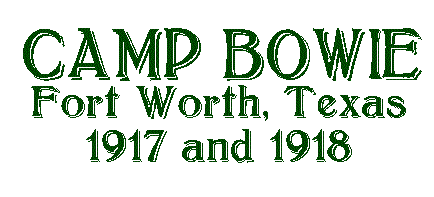
By Jerry Adams
Copyright © 2000
The token:
Q M C / 268 / CAMP BOWIE
(blank reverse)
brass, round, 30mm diameter (all lettering incuse, holed as made) (this is really not a "token" but rather more likely a tool check from the Quartermaster Corps)
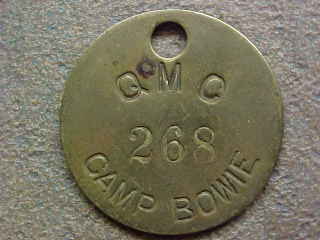
On June 28, 1914 the Archduke Francis Ferdinand, heir to the Austrian throne, and his wife were assassinated in Sarajevo, which quickly brought about a declaration of war by Germany on Russia and France, and the German invasion of Belgium. Austria declared war on Russia, Serbia declared war on Germany, and so on. The nations of Europe plunged headlong into what became the "great war." The war dragged on throughout 1914, 1915, and into 1916. By 1917, the United States declared war on Germany.
In 1916, the Canadian Royal Flying Corps established three airfields around Fort Worth, Texas for the purpose of training pilots for the war in Europe. The three airfields were spread around the edge of the city, and were named Talliaferro Field, Barron Field, and Carruthers Field. Many Americans enlisted in the Canadian military and were assigned to the Fort Worth fields. Thirty-eight Canadian pilots were killed training in the three fields near Fort Worth.
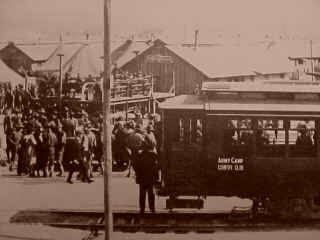
In June of 1917, an U.S. Army commission arrived in Fort Worth searching for the perfect location for an Army training camp. Thousands of soldiers were to be trained, and a camp had to be constructed quickly. Having considered sites south of the Baptist Seminary in south Fort Worth, and an area near Lake Worth, a third site was considered between the old Stove Foundry Road and the streetcar line, on the far west side of the city. It was discovered that the gravel surface of the area, drained quickly, which would provide an excellent natural floor for a large outdoor encampment such as the Army needed. Other factors, which influenced the choice, were proximity to the railroad, and the existing streetcar line, plenty of lumber, adequate civilians employees and utilities.
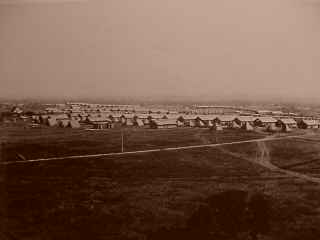
Construction began soon after the July 1917 announcement of the selection, and the plan was to house upwards of 35,000 men at the new camp, which was named after the hero of the Alamo, Jim Bowie. At one time as many as 3,500 carpenters were working at once on the camp, building acres and acres of barracks, barns, gas warfare houses, ammunition magazines, hospitals, warehouses and a railroad spur. The camp was ready by December 1, 1917! The physical size of Camp Bowie ranged from White Settlement Road, to Stove Foundry Road, and from the Seventh Street viaduct far to the west. A large cavalry training center was located at Camp Bowie.
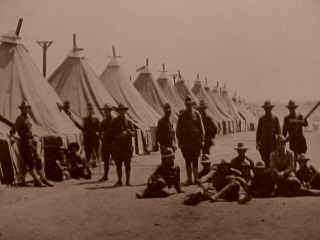
Of the 100,000 men who trained at Camp Bowie in Fort Worth, the biggest threat may have been from the influenza outbreak that swept across the country in 1918. Men were quarantined and could not attend public events, or in some cases could not leave the post. The camp consisted mainly of men living in walled military tents, with Sibley type stoves, wood floors and wood walkways. The cavalry areas could be easily seen by the hitching posts near the tents, and the saddles and tack hanging on the posts.
One of the units stationed at Camp Bowie during the period 1917-1918, include the 144th Infantry Regiment. (Tokens are known to exist from this unit, and have been found in the Camp Bowie area with metal detectors) A large parade was held in downtown Fort Worth on April 11, 1918 for a review of the 36th Division, with General St. John Greble.
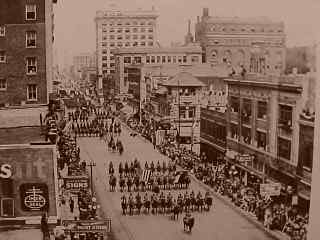
After the war, the camp closed, and the buildings were cannibalized, the area developed quickly into an upscale residential area, which had been its original intent. Nothing is left of the camp, save the name Camp Bowie Boulevard. Still, on occasion, people living in the area along Hulen Street, Pershing Street, and other areas that were in the camp, find small tokens and relics while digging in their gardens.
on to page 24 of our token web pages...
updated : 7 april 2000